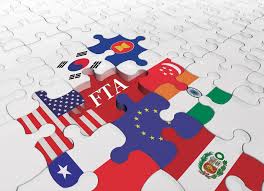FTAs - challenges and opportunities
VGP - Viet Nam signed eight free trade agreements by the end of 2014 and is partaking in talks on seven others, including the Trans-Pacific Partnership (TPP).
 |
Viet Nam expects to complete TPP and Viet Nam-EU free trade agreement in the first half of this year, according to Deputy Minister of Trade and Industry Tran Quoc Khanh.
The above FTAs reflect the Government’s drastic international integration spirit, said Dr. Tran Dinh Thien, Director of the Viet Nam Institute of Economics.
He expressed his belief that some agreeements will be signed this year, creating a fresh framework for national development at high a level of integration.
Mr. Thien said integration offers a new impetus and opportunity for Viet Nam to conduct internal reforms in order to better ourselves.
According to Deputy Minister of Trade and Industry Khanh, FTAs open up opportunities for exports thanks to tax elimination, faciliate our country’s engagement in global supply chain.
We can also restructure export-import markets to avoid heavy dependence on few ones. Currently, 70% of imports come from East Asia which imports 50% of Viet Nam’s exports, he said.
FTAs would help us improve market economy institutions, speed up administration reform, enhance accountability of the public sector in order to make our business environment increasingly transparent and open, he added.
However, hurdles are worth considering. Dr. Tran Dinh Thien said coporate competitiveness is the biggest disadvantage which limits benefits of integration while institutional improvement requires huge efforts.
New FTAs set high standards, including the rules of origin for textile industries, said Mr. Le Tien Truong, General Director of the Viet Nam National Textile and Garmet Group (Vinatex).
Overcoming the weaknesses requires domestic economic structure adjustments, including the system of resource allocation, the Director of Viet Nam Institute of Economics said.
Businesses need to improve their capacity of integration as just 20% of them are aware of the FTAs though information is available on the website of the National Committee for International Economic Integration.
Despite difficulties, there have been a number of successful stories of integration with garment and textile industry setting a good example as it fetched US$15 billion in revenue last year./.
By Hai Minh

